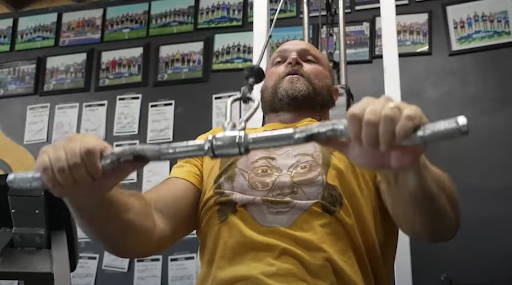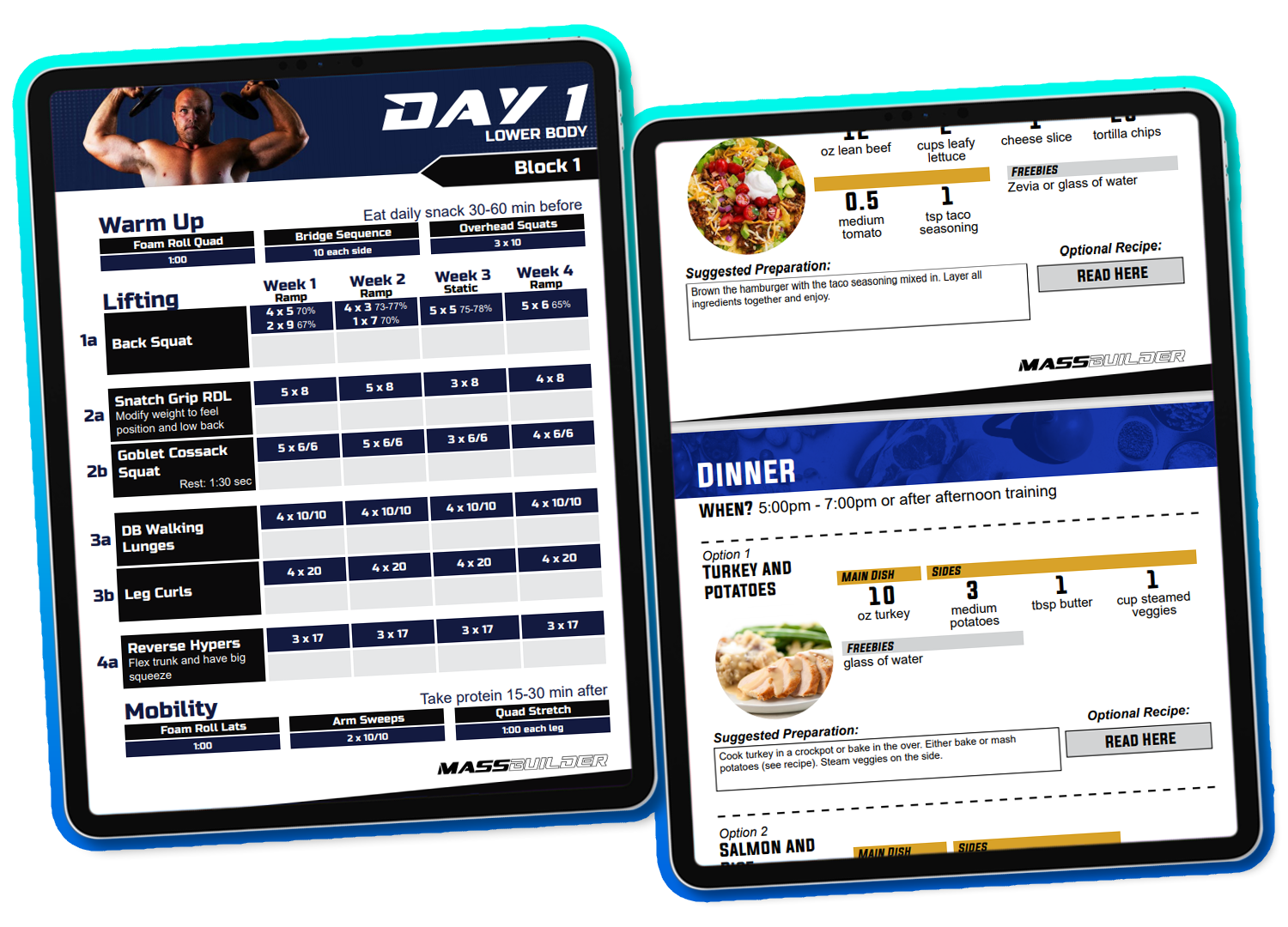Cheat Code for Hypertrophy
Cheat Code To Get Hypertrophic AF
We all have a weak point genetically or even from our limb length relative to training. We could have weak pecs, triceps, or quads. Everyone has some sense of weakness in their muscles. But when we think of being as hypertrophic as possible, we need to look at some old-school bodybuilding principles.
Bodybuilders will typically say there are 5 to 10 key mass movements. Movements like the bench press, back squat/front squat, leg press, deadlift, or movements of that nature stimulate a ton of mass. Movements such as these are the key foundation exercises to building mass. But! Because we all have our genetic disposition, we might not feel or get fatigued in certain areas based on mass movements. For me, my triceps are extremely strong. Bench pressing, my triceps never get sore; my chest always gets sore. The bench press may not be the best exercise for my tricep growth but it might be for my chest growth. Someone else might have a similar issue with chin-ups. Their biceps get destroyed but they don’t feel it in the lats. The inverse may be true for another individual.
Pre-Exhaustion Principle
I’m going to give you pairings that can be used to stimulate a ton of growth. Using me as an example and knowing I have strong triceps, I want to fatigue my triceps before I get on the compound movement. To pre-exhaust, I will use an isolation exercise for about 10 to 17 reps that target the strong muscle group. Then when I get on the compound movement, I will be more stimulated and get more volume, and it will lead to greater growth.
Banded Flies & Bench Press or Tricep Push Downs & Bench Press
One example for an individual with extremely strong pecs, they can hit standing banded flies with PowerLastic bands for a set of 17 reps to fatigue and exhaust the pecs. From doing the flies, I will have pre-exhausted my pec muscles from the flies as I go onto the compound movement of the bench press to get the mass to grow. Not only does this help my pecs, but it also forces my triceps to work harder to overcome the massive load on the compound movement of the bench press.
Using my own body as an example, and as I mentioned before, I never get tricep fatigue from bench pressing. Stolen directly from Dave Draper and Bill Pearl, I do an isolation exercise like a tricep push down. I will do 17 to 20 reps to exhaust my strong muscle group with an isolated movement before moving to the compound movement of the bench press. My strong muscle group, my triceps, then fatigue at the same time as my chest when performing the bench press.

Preacher Curls & Chin-Ups or Lat Pulldowns & Chin-Ups
If we are trying to train another big-time mass movement like a pull-up or chin-up and have really strong biceps, a person may struggle to stimulate their lat strength when doing the upper body pull. What I like to do is fatigue my biceps so that my lats have to work harder when doing the pull-ups. I’ll begin by doing 17 reps of bicep curls with a fat grip preacher curl. Moving over to the pull-up, my biceps being lit up my body is forced to use my lats a little more to execute the pull-up movement.
With extremely strong lats, I want to do the pre-exhaust movement of lat pull-downs. I want to stimulate my lats to be fatigued. Now when returning to the pull-ups, my lats won’t work as well and my biceps will have to take over. Fatiguing the lats before the pull-up will ask the biceps to take over. The biceps will then get more high-threshold motor unit recruitment.
Leg Extensions & Back Squat or Leg Curls & Back Squat
This is a unique pre-exhaustion pairing with the mass-building movement of the back squat. The back squat needs to be executed specifically wherever the problem area occurs. For me, I struggle to feel my quads when back squatting, so I can do leg curls to fatigue the strength in my hamstrings before squatting (we’ll discuss that in a bit). Somebody who struggles with feeling their hamstrings turns on when doing a back squat should fatigue their quads first. Doing a set of 17 leg extensions can do the trick before hitting the back squat. Fatiguing the quads before executing the back squat, the quads feel like they are gone which in turn forces the body to recruit more from the hamstrings to execute the back squat movement.
Now, an athlete who is hamstring dominant (like me), can fatigue their hamstrings through the isolation movement of a leg curl by doing a set of 17 reps. We then can go do the mass building movement of the back squat. Having strong hamstrings, I tend to lean forward and perform what I have dubbed a good morning back squat. Ideally, the pre-exhaustion factor will help my body shift to better movement patterns by loading the quads more, the knees tracking forward, and the chest being upright.

Banded Kickbacks & Strict Press or Lateral Dumbbell Raises & Strict Press
Doing a shoulder press and my shoulders are extremely weak, my triceps are likely taking over during the strict press. Using pre-exhaust principles, I like to do banded PowerLastic Ghostface kickbacks for 15 to 30 reps to fatigue my triceps. Having a nice pump rolling, I can then go over and hit a strict press. With my triceps fatigued, my shoulders will likely take over and since my triceps are already stronger, the muscle groups should fatigue at the same moment which means greater high threshold motor unit recruitment will occur.

If the triceps are the limiting factor on the press, that means I want to stimulate and fatigue my shoulders first. Side lateral raises with dumbbells for 17 reps do this well. The isolation movement will fatigue the delts, traps, and rhomboids and force the triceps to be more active when doing the strict press. With the shoulders blasted, the triceps have to take over more of the stress performing the strict press.
Recap
The key here is to use a mass movement to stimulate overall hypertrophy. The mass movement can be a back squat, deadlift, bench press, strict press, pull-up, and a few others. With pre-exhaustion, the idea is to fatigue the specific area where we are strong to highlight the weak area in the compound movement. In this way, the weak area is stimulated and grown while more high-threshold motor units are recruited, which ideally leads to more hypertrophy in the weak area.
We do have to be careful with pre-exhaustion. We can’t do the pre-exhaustion period for a long time frame. Because we are getting extra volume in our stronger areas, yes our weak areas will get targeted very well in the compound movements, but over multiple weeks the muscles being pre-exhausted start to get extremely swole from all the additional volume. We have to toe a fine line. About 2 to 4 weeks during the comprehension phase of programming is a nice time and length to execute the pre-exhaustion cheat code in training.
Related Posts
Blog Topics

Yo, It's Dane
Welcome to the Garage Strength Blog, where it is my goal to provide you with the experience and knowledge I've gained in the strength and conditioning world over many years of learning from both successes and failures. I train elite-level athletes in a multitude of sports from the high school to professional levels, already producing 5 Olympics and 30+ National Champions. If you want to be the next champion I train, check out my strength programs below!
Start Training With Me

Join for free educational videos EVERY WEEK on strength coaching and athletic performance



